IASbaba's Daily Current Affairs Analysis
Archives
(PRELIMS & MAINS Focus)
Syllabus
- Prelims – Miscellaneous
Context: The BCCI recently announced the (re)introduction of the Yo-Yo Test and the introduction of Dexa scans for the purposes of selection to the team.
About Yo-Yo test:
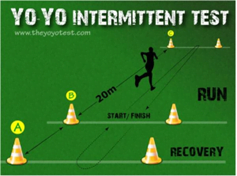
- The Yo-Yo test was first introduced to the Indian cricket team during Virat Kohli’s fitness-focused captaincy reign.
- It is developed by Danish football physiologist Jens Bangsbo.
- It is a maximal aerobic endurance fitness test, involving running between markers placed 20 metres apart, at increasing speeds, until exhaustion.
- Players are given scores on the basis of how many levels they are able to clear.
About Dexa scans:
- Dexa scans were recommended as far back in 2011 because of a significant increase in players’ workloads with the introduction of T20 cricket and professionalisation of the game.
- Through Dexa tests, the trainers will be able to measure body fat percentage, lean muscle mass, water content and bone density.
- It helps you understand where the fat is and whether the training methods are yielding the result.
- They’re often used to help diagnose bone-related health problems, such as osteoporosis, or to assess the risk of getting them.
Source: Indian Express
Previous Year Question
Q.1) Consider the following statements in respect of the ICC World Test Championship:
- The finalists were decided by the number of matches they won.
- New Zealand was ranked ahead of England because it won more matches than England.
Which of the above statements is/are correct? (2021)
- 1 only
- 2 only
- Both 1 and 2
- Neither 1 nor 2
Q.2) Consider the following statement in respect of the 32nd Summer Olympics:
- The Official motto for this Olympics is ‘A New World’.
- Sport Climbing, Surfing Skateboarding, Karate and Baseball are included in this Olympics.
Which of the above statement is/are correct? (2021)
- 1 only
- 2 only
- Both 1 and 2
- Neither 1 nor 2
Q.3) Consider the following statements in respect of the Laureus World Sports Award which was instituted in the year 2000
- American golfer Tiger Woods was the first winner of this award.
- The award was received mostly by ‘Formula One players so far.
- Roger Federer received this maximum number of compared to others
Which of the above statement are correct? (2021)
- 1 and 2 only
- 2 and 3 only
- 1 and 3 only
- 1, 2 and 3
Syllabus
- Prelims – History and Art and Culture
Context: Members of the Jain community have been staging protests in many states including Delhi for the past two weeks over demands related to two holy sites — Sammed Shikhar on Parasnath hill in Jharkhand and Shetrunjay hill in Palitana of Gujarat.
About Sammed Shikharji Jain Temple:
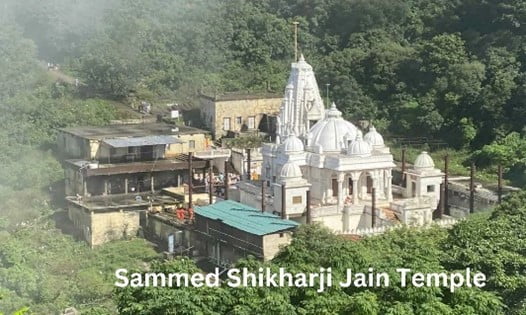
- Shikharji, often spelled Sammed or Sammet Shikharji, is a holy place in the Indian state of Jharkhand’s Giridih district.
- The highest mountain in the state of Jharkhand, Parasnath Hill, is where it is situated.
- Both Digambara and Svetambara consider it to be the most significant Jain Tirtha (pilgrimage destination), as it is the location where twenty of the twenty-four Jain tirthankaras, together with numerous other monks, obtained Moksha.
- The Jnatrdharmakatha, one of the twelve fundamental texts of Jainism, has the first mention of Shikharji as a Tirth (place of pilgrimage).
- The Parsvanathacarita, a biography of Prva written in the eleventh century, also makes mention of Shikharji.
- An illustration of Parshavanatha’s nirvana at Shikharji can be seen in a palm-leaf manuscript of the Kalpa Stra and Kalakacaryakatha from the thirteenth century CE.
- In 1768 CE, Jagat Seth rebuilt the temples at Shikharji to their present configuration.
- The 1678 CE date is written in Sanskrit at the bottom of the image.
- There is a Bhomiyaji temple at the foot of Shikharji (Taleti).
- There is a mural painting of every temple on Parasnath Hill on the walls of the Jain temple in the village of Madhuban.
- The earliest temple to hold a Bhaktamara Stotra yantra is the Svetambara Bhaktamara temple, founded by Acharya Ramchandrasuri.
About Shetrunjay Hill:
- The hills are located in Palitana city of Bhavnagar district in Gujarat.
- The hills are located on the banks of river Shetrunji and are considered as a sacred hill by Jains.
- The hills are bounded by the Gulf of Khambhat in the south and Bhavnagar town in the north.
- Shatrunjaya translates to Place of Victory.
- The temples atop this hill is said to have been built more than 900 years ago, and are grouped into enclosures.
- Jains believe that Adinath, who is the founder of Jainism, had meditated beneath the tree at the summit of this place.
- The temple complex here also has a shrine of a Muslim saint, Angar Pir.
- The most important temple of all here is the Adinath Temple, located on the highest point of the place.
About Shetrunji River:
- It is an eastward-flowing river in Gujarat. The river rises in the northeast of Gir Hills. The river has a maximum length of 227 kilometres.
Source: Indian Express
Previous Year Questions
Q.1) With reference to Indian history, consider the following pairs:
Historical person Known as
- Aryadeva Jaina scholar
- Dignaga Buddhist scholar
- Nathamuni Vaishnava scholar
How many pairs given above are correctly matched ?
- None of the pairs
- Only one pair
- Only two pairs
- All three pairs
Q.2) With reference to the history of ancient India, Bhavabhuti, Hastimalla and Kshemeshvara were famous (2021)
- Jain monks
- playwrights
- temple architects
- philosophers
Syllabus
- Prelims – Geography
Context: According to a UNICEF recent publication, nearly 70 per cent of the Intergovernmental Authority on Development (IGAD) region comprise arid and semi-arid lands prone to recurrent droughts in the horn of Africa.
About Horn of Africa:

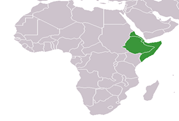
- The Horn of Africa (alternatively Northeast Africa, and sometimes Somali Peninsula) is a peninsula of East Africa that juts for hundreds of kilometers into the Arabian Sea, and lies along the southern side of the Gulf of Aden.
- It is the easternmost projection of the African continent.
- It indeed resembles in outline the horn of an animal — perhaps especially, the horns of the Black Rhinoceros, whose historic range includes parts of Ethiopia:
- The angle between its northern and south eastern coasts approximates that at the tip of the rhino’s upper horn.
- The concavity of its northern coast, and convexity of its southern, echo similar curvatures on the rhino’s lower horn.
- The term also refers to the greater region containing the countries of Djibouti, Ethiopia, Eritrea and Somalia. As such, it covers approximately 2,000,000 km² and is inhabited by about 86.5 million people.
- Sudan and Kenya are sometimes included as well.
- The Horn of Africa is a UNESCO Biodiversity Hotspot and one of the two entirely arid ones.
- However the Horn of Africa suffers largely from overgrazing and only 5% of its original habitat still remains.
Geography and climate
- The Horn of Africa, almost equidistant from the Equator and the Tropic of Cancer, is an arid region.
- Socotra is a small island off the coast of Somalia, in the Indian Ocean, that is considered to be part of Africa. Its size is 3,600 square km. It is a territory of Yemen, the southernmost country on the Arabian peninsula.
Economy: States of the region depend largely on a few key exports:
- Sudan: Cotton 50% of total exports.
- Ethiopia: Coffee 80% of total exports.
- Somalia: Bananas and livestock over 50% of total exports.
Source: DownToEarth
Previous Year Questions
Q.1) Consider the following pairs:
Region often mentioned in the news: Country
- Anatolia Turkey
- Amhara Ethiopia
- Cabo Delgado Spain
- Catalonia Italy
How many pairs given above are correctly matched? (2022)
- Only one pair
- Only two pairs
- Only three pairs
- All four pairs
Q.2) Which one of the lakes of West Africa has become dry and turned into a desert?
- Lake Victoria
- Lake Faguibine
- Lake Oguta
- Lake Volta
Syllabus
- Prelims – Science and Technology
Context: Scientists from South Korea have developed a new water purification system that can quickly and efficiently filter out microplastics. Crucially, the polymer used is relatively inexpensive with excellent adsorption performance and good photothermal properties.
About Microplastics:

- Microplastics are those particles with less than 5 millimeters (0.2 inches).
- There are two types:
- primary microplastics and
- secondary microplastics.
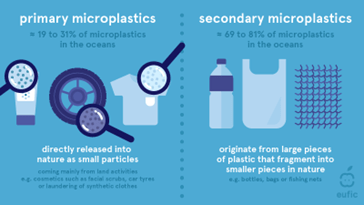
- Primary microplastics are directly designed for commercial purposes:
- Nurdles: small pellets that put together, melted and molded to make larger plastic shapes;
- Microbeads: which are used in personal care products to help scrub off dead skin;
- Fibers: many clothes today are made of synthetic plastic fibres like nylon and polyethylene terephthalate (PET).
- Secondary microplastics are formed as large, original plastic pieces break down into millions of smaller pieces.
Major sources of Microplastics:

- Plastic materials are either originated at land or at the ocean.
- Around 70-80% of ocean plastics have land-based sources, while 20-30% of plastics come from marine sources.
- Of the plastic materials coming from marine sources, half is estimated to be caused by fishing fleets that leave behind fishing nets, lines, ropes, and sometimes abandoned vessels.
- Regarding land waste, discarded plastic materials enter the marine environment as trash, industrial discharge, or litter via inland waterways, wastewater outflows, and wind transport.
- While 25% of land-based discharges come from within the waste management system, the largest slice, 75% is uncollected waste.
Effects of microplastics on human health:
- A case of the World Health Organization (WHO) claims with respect to drinking water, that “microplastics are increasingly found in drinking water, but there is no evidence so far that this poses a risk to humans.”
- It is also known that the human body’s excretory system eliminates microplastics, likely disposing of > 90% of ingested micro- and nano plastic via faeces.
- However, other studies suggest microplastics with particular characteristics can move across living cells and impact the immune system and cell health.
- Ingested microplastics may cause inflammation in tissue, cellular proliferation, and necrosis and may compromise immune cells.
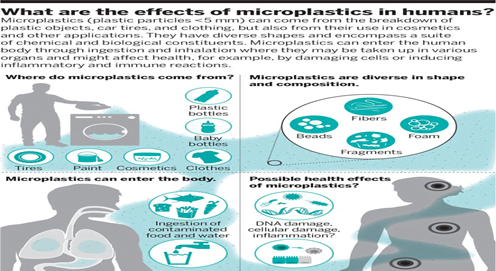
Source: Indian Express
Previous Year Questions
Q.1) Consider the following statements:
- Other than those made by humans, nanoparticles do not exist in nature.
- Nanoparticles of some metallic oxides are used in the manufacture of some cosmetics.
- Nanoparticles of some commercial products which enter the environment are unsafe for humans.
Which of the statements given above is/are correct? (2022)
- 1 only
- 3 only
- 1 and 2
- 2 and 3
Q.2) “Triclosan” considered harmful when exposed to high levels for a long time, is most likely present in which of the following? (2022)
- Food preservatives
- Fruit ripening substances
- reused plastic containers
- Toiletries
Syllabus
- Prelims – Science and Technology
Context: Recently telescopes operated by National Aeronautics and Space Administration (NASA) observed a tidal disruption event named AT2021ehb.
- This is the fifth-closest example of a black hole destroying a star occurred 250 million light-years from the earth, in the centre of another galaxy.
- It was first spotted in March 2021, by the Zwicky Transient Facility in Southern California.
- It took place in a galaxy with a central black hole about 10 million times the mass of our sun.
About Tidal Disruption Event (TDE):
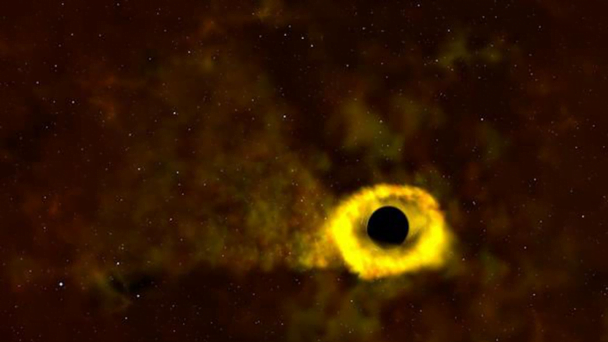
- It is a phenomenon of the destruction of a star by a black hole.
- Gradual growth of this material bound to the black hole produces a short-lived flare of emission, known as a ‘Tidal disruption event’.
- Tidal force: It is a difference in the strength of gravity between two points.
- If it is greater than the intermolecular force that keeps it together, the body will get disrupted.
- Tidal force of a black hole disrupts the star in vicinity.
- About half of the star’s debris continues on its original path, the other half is attracted by the black hole’s gravitational pull.
- TDE provides spectacular view of the corona’s formation and evaluation.
About NuSTAR Mission:

- The Nuclear Spectroscopic Telescope Array, or NuSTAR, mission studies the universe in high energy X-rays to better understand the dynamics of black holes, exploding stars and the most extreme active galaxies.
- In addition to complementing astrophysics missions studying the universe in various spectra, NuSTAR, the first hard-focusing X-ray telescope to orbit Earth, is expected to greatly improve on observations from ground-based observatories.
- NuSTAR science discoveries and highlights:
- First measurement of black hole spin with high precision
- Untangling the mystery of how stars explode
- The discovery of a shockingly bright dead star
- Staring deep into the hidden lairs of black holes
- Contributed to the first picture of a black hole.
Source: The Hindu
Previous Year Question
Q.1) If a major solar storm (solar flare) reaches the Earth, which of the following are the possible effects on the Earth? (2022)
- GPS and navigation systems could fail.
- Tsunamis could occur at equatorial regions.
- Power grids could be damaged.
- Intense auroras could occur over much of the Earth.
- Forest fires could take place over much of the planet.
- Orbits of the satellites could be disturbed.
- Shortwave radio communication of the aircraft flying over polar regions could be interrupted.
Select the correct answer using the code given below:
- 1, 2, 4 and 5 only
- 2, 3, 5, 6 and 7 only
- 1, 3, 4, 6 and 7 only
- 1, 2, 3, 4, 5, 6 and 7
Syllabus
- Prelims: International Affairs
In News: India will take over the leadership of the Asian Pacific Postal Union (APPU) having its Headquarters in Bangkok, Thailand from January.
Asian Pacific Postal Union (APPU)
- An intergovernmental organization of 32-member countries of the Asian-Pacific region.
- The only Restricted Union of the Universal Postal Union (UPU) in the region, which is a specialised agency of the United Nations
- Goal:
- To extend, facilitate and improve postal relations between member countries and to promote cooperation in the field of postal services.
- APPU also takes the lead in ensuring that all technical and operational projects of UPU are fulfilled in the region so that it is integrated into the global postal network in the best possible way.
This is the first time an Indian is leading an international organization in the postal sector.
Source: News on AIR
Syllabus
- Prelims: Current Affairs (International Institutions)
In News: Several loan agreements have been signed by the Government and the Asian Development Bank to boost the infrastructure sector in the country.
- A loan agreement was signed worth 350 million US dollars to improve connectivity in Maharashtra
- A loan agreement worth 300 million US dollars will be utilised to upgrade over 300 kilometres of State highways and major district roads in Assam.
- A 220 million dollar loan agreement was signed to improve energy security, quality of supply, efficiency, and resilience of the power sector in Tripura.
- A loan agreement worth 350 million US dollars was signed to build new lines and improve the connectivity of the metro rail system in Chennai.
About Asian Development Bank
- ADB was conceived in the early 1960s as a financial institution that would be Asian in character and foster economic growth and cooperation in one of the poorest regions in the world.
- A resolution passed at the first Ministerial Conference on Asian Economic Cooperation held by the United Nations Economic Commission for Asia and the Far East in 1963 set that vision on the way to becoming reality.
- The Philippines capital of Manila was chosen to host the new institution, which opened in 1966, with 31 members that came together to serve a predominantly agricultural region. Takeshi Watanabe was ADB’s first President.
- During the 1960s, ADB focused much of its assistance on food production and rural development.
- In May 2014, plans were announced to combine the lending operations of ADB’s two main funds, the Asian Development Fund, and its ordinary capital resources. The merger will boost ADB’s total annual lending and grant approvals to as high as $20 billion—50% more than the current level when it takes effect in January 2017.
- From 31 members at its establishment in 1966, ADB has grown to encompass 68 members including India—of which 49 are from within Asia and the Pacific and 19 outside.
- This bank was modelled on the lines of the world bank. As of 31st December 2021, Japan holds the largest share in ADB with 15.677%, followed by U.S.A (15.567%), China (6.473%), and India (5.812%).
- It is headquartered in Manila, Philippines.
Other existing Agreements:
- ADB and India have signed a loan of $206 million to strengthen urban services in 5 Tamil Nadu cities.
- Asian Development Bank (ADB) has listed its 10-year masala bonds worth Rs 850 crore on the global debt listing platform of India INX.
- Asian Development Bank (ADB) had prepared a Conceptual Development Plan (CDP) for Vizag-Chennai Industrial Corridor (VCIC).
Source: News on AIR
Syllabus
- Prelims: Economy
In News: India has the potential to become a world leader in footwear and leather with the efforts of both government and industry.
Leather industry in India
- India is the second largest producer of footwear and leather garments after China in the world
- It is the second largest exporter (after China) of leather garments in the world.
- The industry is known for its consistency in high export earnings and it is among the top ten foreign exchange earners for the country.
- India has an abundance of raw materials with access to 20% of world’s cattle and buffalo and 11% of the world’s goat and sheep population.
- The Leather industry is an employment-intensive industry providing job to more than 4 mn people, mostly from the weaker sections of the society.
- With 30% share, women employment is predominant in Leather products industry
- Has one of the youngest workforces with 55% of the workforce below 35 years of age.
- Major Markets: USA, Germany, UK, Italy, France, Spain, Netherlands, UAE, etc.
Background of leather industry:
- During 70s the industry was mostly exporting raw hides and skins. Based on Seetharamaiah Committee recommendations, in 1973, the Government has banned the export of raw hides and skins and introduced quota on the export of semi-finished leathers and several incentives for exporting finished leathers and products.
- As a result, and many positive developments both within and outside the country, the structure of the industry has undergone changes in a phased manner.
- During early 80s India’s export basket consisted of mainly finished leathers. But mid-80 onwards the share of leather products has been gradually increasing. At present more than 80% of India’s leather exports consist of finished products.
- The Council for Leather Exports (popularly known as CLE) set up in July 1984, is an autonomous non-profit company registered under the Indian Companies Act, 1956 entrusted with export promotion activities and development of the Indian leather industry.
- Today we don’t export any raw material but only finished leather and leather products.
- As of today, in terms of volume, we are the second-largest producer of footwear, largest producer of saddlery and the second-largest producer of leather garments.
Strength of Indian leather industry:
- Own raw material source – About 3 billion sq ft of leather produced annually
- Some varieties of goat/calf / sheep skins command premium position
- Strong and eco-sustainable tanning base
- Modernized manufacturing units
- Trained / skilled manpower at competitive wage levels
- World-class institutional support for Design & Product Development, HRD and R & D.
- Presence of support industries like leather chemicals and finishing auxiliaries
- Presence in major markets – Long Europe experience
- Strategic location in the Asian landmass
Schemes by Government: The Government is working on formulating a new scheme to support the manufacturing of machinery required in the industry + The existing six sub-schemes:
- Sustainable Technology and Environmental Promotion(STEP):-Assistance for each Common Effluent Treatment Plant (CETP)
- Integrated Development of Leather Sector (IDLS):-Assistance to be provided to the sectoral units for their modernization/capacity expansion/technology upgradation (Financial assistance, domestic manufactured machinery)
- Mega Leather Footwear and Accessories Cluster Development (MLFACD):Assistance is provided for land development, core infrastructure, social infrastructure, production facilities including ready to use sheds with plug and play facility, R&D support and export services
- Establishment of Institutional Facilities (EIF):-Assistance would be provided for establishment/upgradation of the institutional infrastructure of Footwear Design and Development Institute (FDDI).
- Brand Promotion of Indian Brands in Footwear and Leather Sector
- Development of Design Studios in Footwear and Leather Sector: A one-stop- shop providing a wide range of services: design, technical support, quality control, etc. to promote marketing/export linkages, facilitate buyer- seller meets, display designs to international buyers and work as an interface for the trade fairs.
Source: News on AIR
Syllabus
- Prelims: Modern History, Society
Who was Savitribai Phule?
- A Dalit woman from the Mali community, Savitribai was born on January 3, 1831, in Maharashtra’s Naigaon village.
- She was married off at the tender age of 10 to Jyotirao Phule
- He educated her at home and later, Jyotirao admitted Savitribai to a teachers’ training institution in Pune.
- Throughout their life, the couple supported each other and in doing so, broke many social barriers.
Savitribai Phule, the social reformer is considered to be one of India’s first modern feminists.
- A revolutionary Indian woman who began the mission to educate women in India.
- She relentlessly fought against the dominant caste system and worked towards the upliftment of the marginalized.
Early Life and Work
Savitribai went on to become India’s first woman teacher and headmistress. It is her struggle and story that marks the beginning of modern Indian women’s public life in India.
- The extraordinary couple (married to Jyotirao) was engaged in a passionate struggle to build a movement for equality between men and women and a fight against the caste system. They dedicated their lives to spreading education and knowledge. They started the first school in the country for girls and the ‘Native Library’.
- In 1863, they started a ‘home for the prevention of infanticide’ in their own house, to ensure the safety of pregnant and exploited widows.
- They also established the Satyashodhak Samaj (Society for Truth Seeking), initiating the practice of marriage without dowry or overt expenses. Satyashodhak Samaj was founded with the purpose to give education to the lower castes, scheduled caste, and scheduled tribes and making them aware of the exploiting tradition of society.
- They were against child marriage and supported widow remarriages.
- They had no children of their own but adopted a child of a Brahmin widow, educating him and arranging an inter-caste marriage for him.
Struggles she faced
On teaching women
- Savitribai’s struggle was fraught with many difficulties and despite that she continued her work peacefully. Men would purposely wait in the streets and pass lewd remarks. They sometimes pelted stones and threw cow dung or mud.
- Savitribai would carry two saris when she went to school, changing out of the soiled sari once she reached school, which would again be soiled on her way back, and yet, she did not give up.
- The guard who was then appointed for her, wrote in his memoirs about what she would say to those men, “As I do the sacred task of teaching my fellow sisters, the stones or cow dung that you throw seem like flowers to me. May God bless you!”
- The couple also set up ‘Balyata Pratibandak Gruha’, a childcare centre for the protection of pregnant widows and rape victims. Urging women to break free of caste barriers, Savitribai encouraged them to sit together at her meetings.
- Savitribai Phule published her first collection of poems, called Kavya Phule (‘Poetry’s Blossoms’), at the age of 23 in 1854. She published Bavan Kashi Subodh Ratnakar (‘The Ocean of Pure Gems’), in 1892.
When Jyotirao passed away
- When Jyotirao passed away, he could not be buried with salt covering his body as he had wished.
- He was burnt on the pyre and it was Savitribai who courageously came forward and held the earthen pot (it is supposed to be carried by the successor of the deceased). She led the final journey of Jyotirao and consigned his body to the flames.
- In the history of India, this was probably the first time a woman had performed death rites.
- She also erected a ‘Tulsi Vrindavan’ with his ashes on the spot where Jyotirao wanted to be buried.
- After Jyotirao’s demise, Savitribai led the Satyashodhak movement till the very end. She was the chairperson of the Satyashodhak Conference held in 1893 at Saswad, Pune.
Death
- The year 1897 dawned with the menace of plague. People were dying in hundreds daily in Pune.
- The government tried to control the epidemic under the leadership of officer Rand.
- Savitribai along with Yeshwant set up a hospital to take care of the patients.
- She would herself pick up sick people and bring them to the hospital and treat them. Even though she knew that the disease was contagious, she continued to serve them till the plague took her own life.
One of her most loved and valued poems:
Go, Get Education
Be self-reliant, be industrious
Work—gather wisdom and riches,
All gets lost without knowledge
We become animal without wisdom,
Sit idle no more, go, get education
End misery of the oppressed and forsaken,
You’ve got a golden chance to learn
So learn and break the chains of caste.
Throw away the Brahman’s scriptures fast.
– Savitribai Phule (Kavya Phule, 1854)
News Source: Indian Express
Syllabus
- Mains – GS 2 (Governance)
Context: Marumalarchi Dravida Munnetra Kazhagam (MDMK) general secretary recently warned that the Union government might introduce a Bill for a uniform civil code soon as a private member Bill on the issue moved in the Rajya Sabha by BJP member Kirodi Lal Meena secured 63 votes, and only 23 persons voted against its introduction.

About Uniform Civil Code (UCC):
- The Uniform Civil Code (UCC) calls for the formulation of one law for India, which would be applicable to all religious communities in matters such as marriage, divorce, inheritance, adoption.
Origin of Uniform Civil Code:
- It dates back to colonial India when the British government submitted its report in 1835 stressing the need for uniformity in the codification of Indian law relating to crimes, evidence, and contracts, specifically recommending that personal laws of Hindus and Muslims be kept outside such codification.
- An increase in legislation dealing with personal issues at the far end of British rule forced the government to form the B N Rau Committee to codify Hindu law in 1941.
- The task of the Hindu Law Committee was to examine the question of the necessity of common Hindu laws.
- The committee, in accordance with scriptures, recommended a codified Hindu law, which would give equal rights to women.
- The 1937 Act was reviewed and the committee recommended a civil code of marriage and succession for Hindus.
Constitutional Provisions:
- Article 44: The “State shall endeavour to provide for its citizens a uniform civil code (UCC) throughout the territory of India.”
- Article 37: The “state shall endeavour by suitable legislation”, while the phrase “by suitable legislation” is absent in Article 44.
Inclusion in DPSP:
- The Uniform Civil Code (UCC) was included in the Directive Principles, not in the Fundamental Right which is enforceable by the Court of Law due to the following reasons:
- Muslims members opposed it in the Constituent Assembly (CA).
- The pain of partition on the religious ground was still not diminished.
- The stand taken by B.R. Ambedkar in the Constituent Assembly was that a UCC is desirable but for the moment should remain voluntary.
Significance of UCC:
- Uniform Principles: Common Code would enable uniform principles to be applied in respect of aspects such as marriage, divorce, succession etc. so that settled principles, safeguards and procedures can be laid down and citizens are not made to struggle due to the conflicts and contradictions in various personal laws.
- Promotion of secularism: One set of laws to govern the personal matters of all citizens irrespective of religion is the cornerstone of true secularism.
- It would help end gender discrimination on religious grounds and strengthen the secular fabric of the nation.
- Protection of Vulnerable and Women’s Rights: It will protect the vulnerable sections of society.
- Women have been denied via personal laws in the name of socio-cultural-religious traditions.
- Therefore UCC could bring all communities together to ensure Women the Right to a dignified life and control over their life as well as body.
- Reduced Discord: if and when the whole population will start following the same laws, chances are there that it would bring more peace in the living and reduce riots.
- Hence, Religious harmony will be created for peaceful living in the country
- Prevents religion-based discrimination: Personal laws differentiate between people on grounds of religion. A unified law having the same provisions regarding marital affairs would provide justice to those who feel discriminated against.
- Ending unjust customs and traditions: A rational common and unified personal law will help eradicate many evil, unjust and irrational customs and traditions prevalent across the communities.
- For example, Law against Manual scavenging. It might have been a custom in the past but in a mature democracy like India, this custom cannot be justified.
- Remove vote bank politics: Opting the UCC will remove the religious nexus of the Political system in which voters are divided on the basis of religion, caste etc.
- Eases Administration: UCC would make it easy to administer the huge population base of India.
- Global practice of UCC: Almost all Muslim nations like Morocco, Pakistan etc. have been following the UCC.
- National integration: A common civil code will help the cause of national integration by removing disparate loyalties to laws that have conflicting ideologies. No community is likely to bell the cat by making gratuitous concessions on this issue. It is the State which is charged with the duty of securing a uniform civil code for the citizens of the country and, unquestionably, it has the legislative competence to do so.
- Best Practice: While delivering a judgment legitimising the Portuguese Civil Code of 1867, the Supreme Court reportedly described Goa as a “shining example” with a Uniform Civil Code.
Arguments against UCC:
- Dominant religion’s codes: It is believed that it could make dominant religion’s codes and norms universal, and require minority religions to assimilate to those norms, while abandoning the tenets of their faith.
- It will assert cultural hegemony, in a State that is growing increasingly majoritarian.
- Violates right to religion (Article 25): Article 25 gives every religious group the right to manage its own affairs.
- Article 29 gives them the right to conserve their distinct culture.
- In Constituent Assembly, fundamental rights sub-committee headed by Sardar Vallabhbhai Patel said that UCC was outside the scope of fundamental rights and therefore it was made less important than freedom of religion.
- Several communities, mainly minority communities, perceive the Uniform Civil Code as an encroachment on their rights to religious freedom.
- Diversity in India: It is tough to come up with a common and uniform set of rules but our government is trying to come up with common rules.
View of Judiciary on UCC: Courts in India, including the Supreme Court, have time and again questioned why a UCC is yet to be introduced.
- During the Mohd Ahmed Khan v. Shah Bano Begum and Others (1985) case, the top court exhorted the central government to enact a “common civil code” in the interests of national integration.
- The Court reiterated the same, in context of a marriage between a Christian woman and a Sikh man under the Indian Christian Marriage Act, 1872 in Jordan Diengdeh v. S S Chopra (1985).
- Court observed “Time has now come for the intervention of the legislature to provide for a uniform code of marriage and divorce as envisaged by Article 44.”
- Case of Goa: Goa is the only state in India where all communities, including Hindus, Muslims, Christians, are governed by the same law when it comes to marriage, divorce, succession, etc. as it is governed by the Portuguese Civil Code of 1867 for all communities in the state.
Way Forward:
- Gender equality in UCC: Before framing UCC first need to ensure gender equality in UCC.
- Making UCC voluntary: If a person is free to choose whether they want to be governed by personal law, or by a non-religious civil code, there is no reason why UCC and personal laws cannot co-exist, instead of one replacing the other.
- For example: People who do not wish to marry under personal laws can marry under the Special Marriage Act (albeit not without problems and inconveniences).
- Codification of all personal laws as suggested by the Law Commission: By codification of different personal laws, one can arrive at certain universal principles that prioritize equity rather than the imposition of a Uniform Civil Code.
- To resolve the contentious issues like UCC, common consensus of all the stakeholders is needed.
Thus, framing the voluntary and gender equal uniform civil code is in need to provide equality to the citizens across the country. Instead of considering whether India needs a Uniform Civil Code, India should focus on how to make sure that every person in India has the option to be governed by a civil code that is fair to all genders.
Source: The Hindu
Syllabus
- Mains – GS 3 (Economy)
Context: Recently, the government plans to use the technology across all export-driven crops to increase the country’s food shipments and incentivise farmers to take up chemical-free processes. India’s natural farming could soon get a technological push through blockchain.
About Blockchain technology:
- Blockchain is a shared, immutable ledger that facilitates the process of recording transactions and tracking assets in a business network.
- An asset can be tangible (a house, car, cash, land) or intangible (intellectual property, patents, copyrights, branding).
- Virtually anything of value can be tracked and traded on a blockchain network, reducing risk and cutting costs for all involved.
- It distributes privileges to all network members rather than having a single server and administrator.
- Multiple parties can then access and validate new database additions, increasing security and lowering the risk of corruption.
Applications of Blockchain in Agriculture:
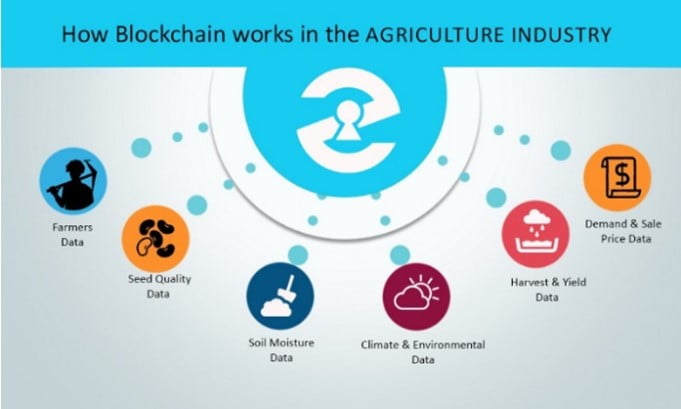
- Food Supply Chain: Due to the sheer pressures of globalisation, the agricultural food supply chain has become longer and more intensive than ever before. Blockchain technology contributes to the resolution of many of these challenges by facilitating the establishment of trust between producers and customers.
- Agricultural Insurance: Farmers can choose from a variety of insurance policies that differ in terms of how losses are calculated and pay-outs are made.
- Smart farming: It incorporates elements such as ICT, the internet of things (IoT), different sensors, machine learning technologies, and a plethora of data analysis and collection equipment such as unmanned aerial vehicles.
- Transactions of Agricultural Products: With the use of blockchain technology, the acquisition and selling of agricultural products on ecommerce sites may be substantially accelerated.
Advantages of Blockchain in Agriculture:
- Supply chain transparency: The data can improve supply chain transparency and eliminate concerns associated with illegal and unethical operations.
- Recall: In the case of a recall, they can also make it easier to track any contamination or other issues back to their source.
- Food security: The primary goals of these technologies are sustainability and food security.
- Transparency: When consumers have this amount of transparency, they can make informed purchasing decisions.
- Information: Blockchain technologies can track all types of information about plants, such as seed quality, and crop growth, and even generate a record of the journey of the plant after it leaves the farm.
- Reward: This can be utilised to reward farmers and producers that implement good farming methods.
- It is easy and simple to discover and report instances of blockchain failures or fraud: The usage of smart contracts also makes it easy to report any problems in real time.
- The absence of a central authority figure alters the nature of the transaction’s trust. Rather than relying on an authority, confidence is placed in peer-to-peer systems and cryptography.
Disadvantages of Blockchain in Agriculture:
- Misuse: Concerns have been raised that blockchain technology could be misapplied or misused, putting food security at risk.
- For example, privately held blockchains are easier to hack and less secure.
- Lack of research: Many issues must be resolved before blockchain technology can be completely incorporated into agriculture.
- Implementation must enable sustainable and equitable food systems, allowing consumers to make a better decision.
- Small-scale farmers: who lack the necessary size, technological know-how, and scalability to take advantage of blockchain technology, may be left behind.
- Farmers that cannot afford blockchain face a significant hurdle to adoption: While setting up the ledger is very affordable, the process of collecting data may be time consuming and costly.
Way Forward:
- Those who lack the digital literacy required to engage in blockchain technology must be educated through campaigns like #knowblockchainstech.
- This is part of the system’s decentralisation process.
- Because of aged infrastructure and a lack of digital literacy, the world’s poor may be unable to participate.
- Blockchain implementation must be decentralised to accommodate small farmers and rural dwellers which will further strengthen food security.
- It can improve security by prohibiting unethical crop production and distribution, which endangers farmers’ livelihoods.
- The Consumers will be able to make more educated decisions due to blockchain’s data collection, and they may even be able to help small-scale farmers who are often in need of food and financial security.
Source: The Economic Times
Baba’s Explainer -Demonetisation Verdict
Syllabus
- GS-3: Economy and issues relating to planning, mobilization, of resources, growth, development and employment.
- GS-3: Money Laundering
- GS-2: Governance
Context: Recently, Supreme Court in the majority opinion (4-1) upheld the government’s demonetisation order of November 8, 2016. However, Justice B V Nagarathna disagreed with the reasoning and conclusions in the majority opinion.
Read Complete Details on Demonetisation Verdict
Practice MCQs
Q.1) Consider the following pairs:
Jain temple and location
- Sammed Shikharji – Odisha
- Gomateshwara temple – Karnataka
- Shetrunjay Hill – Gujarat
How many pairs given above is/are correctly matched?
- None of the above
- One pair only
- Two pairs only
- All three pairs
Q.2) The Yo-Yo test and Dexa scan often mentioned in news related to
- Sports
- Law and order
- Traffic management
- none of the above
Q.3) Consider the following countries:
- Djibouti,
- Ethiopia,
- Egypt
- Somalia
Which of the above makes the part of Horn of Africa?
- 1 2 and 3 only
- 2 3 and 4 only
- 1 2 and 4 only
- 1 3 and 4 only
Comment the answers to the above questions in the comment section below!!
ANSWERS FOR ’ 4th January 2023 – Daily Practice MCQs’ will be updated along with tomorrow’s Daily Current Affairs.st
ANSWERS FOR 3rd January – Daily Practice MCQs
Q.1) – b
Q.2) – b
Q.3) – c














